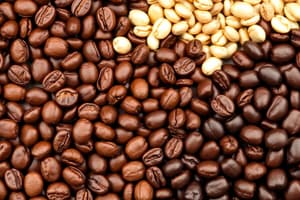Podcast
Questions and Answers
Which of the following best describes 'terroir' in the context of coffee production?
Which of the following best describes 'terroir' in the context of coffee production?
- A specific method of roasting coffee beans to enhance their flavor.
- The altitude at which coffee is grown, directly impacting its acidity and body.
- The unique combination of soil, topography, and climate that influences the quality and flavor of coffee. (correct)
- A blend of different coffee beans from various regions to create a complex flavor profile.
If a coffee blend involves roasting different coffees separately using different roast curves before combining them, it is known as what type of blend?
If a coffee blend involves roasting different coffees separately using different roast curves before combining them, it is known as what type of blend?
- Single-Origin Blend
- Multi-Origin Blend
- Pre-Roast Blend
- Post-Roast Blend (correct)
Microfoam, essential for a latte, is created by incorporating what into milk?
Microfoam, essential for a latte, is created by incorporating what into milk?
- Flavored syrups
- Small microbubbles (correct)
- Finely ground coffee particles
- A blend of cream and sugar
The 'Swiss Water Process' is primarily used in coffee production for what purpose?
The 'Swiss Water Process' is primarily used in coffee production for what purpose?
Which grind size is typically recommended for stovetop espresso machines and vacuum pots?
Which grind size is typically recommended for stovetop espresso machines and vacuum pots?
What are the three essential components that a barista should evaluate in a perfect shot of espresso?
What are the three essential components that a barista should evaluate in a perfect shot of espresso?
If a coffee is described as 'clean', what characteristic does this primarily refer to?
If a coffee is described as 'clean', what characteristic does this primarily refer to?
Which of the following is a key aspect of 'ethical sourcing' in the coffee industry?
Which of the following is a key aspect of 'ethical sourcing' in the coffee industry?
A coffee described as 'single-origin' is characterized by what?
A coffee described as 'single-origin' is characterized by what?
What are the three basic ingredients needed to brew coffee?
What are the three basic ingredients needed to brew coffee?
Flashcards
Terroir
Terroir
Local combination of soil, topography, and climate affecting coffee flavor.
Blending
Blending
Combining different roasted coffees to create new flavors.
Post-Roast Blend
Post-Roast Blend
Coffee roasted separately then blended.
Pre-Roast Blend
Pre-Roast Blend
Signup and view all the flashcards
Microfoam
Microfoam
Signup and view all the flashcards
Flavorlock
Flavorlock
Signup and view all the flashcards
Swiss Water Process
Swiss Water Process
Signup and view all the flashcards
Sumatra
Sumatra
Signup and view all the flashcards
Elegant
Elegant
Signup and view all the flashcards
Altitude
Altitude
Signup and view all the flashcards
Study Notes
- Gazebo Blend is a light, sparkling blend, ideal iced or brewed hot.
- Terroir is the soil, topography, and climate combination impacting coffee quality and flavor.
- The Starbucks Coffee Trading Company is located in Lausanne, Switzerland.
- Blending offers flexibility to create flavors not found in single-origin coffees.
Roast Blends
- Post-Roast Blend: Different coffees roasted separately, then blended.
- Pre-Roast Blend: Different green coffees combined and roasted together.
- Barista: Delivers the Starbucks Experience to every customer.
- Microfoam: Small bubbles incorporated in milk create a smooth, glossy, creamy texture.
- Flavorlock packaging maintains the fresh taste of roasted coffees.
- Caffeine: A mild stimulant in over 60 plants like coffee and tea.
- Swiss Water Process: Removes caffeine from green beans by soaking in warm water.
- Coffee is made when hot water extracts and mixes with the flavor components in ground coffee.
- Fine grind is recommended for stovetop espresso machines and vacuum pots.
- Fair Trade Certified: Applies to coffee produced by democratically-run, small-scale, family-owned farms.
Espresso
- Espresso's distinct parts: heart, body, and crema.
- Coffees with little aftertaste are described as clean.
- Conservation International (CI): Aims to protect biodiversity and harmonious human-nature coexistence.
- 100 Million Coffee Trees Initiative combats coffee leaf rust in Latin America.
- Robusta: A hardy coffee species resistant to disease, pests, and drought.
- Gesha: Heirloom celebrated for its delicate cup profile.
- Green Bean: The actual coffee bean (seed).
- French Press highlights the body of the coffee.
- Café Verona: Can be used to brew espresso shots during an Espresso Roast shortage.
- Five sets of double shots should be pulled from the Mastrena II to properly time espresso shots.
- 27 grams of coffee is used to brew a 4-cup press.
- The taste of a perfect shot of espresso should be sweet and intense with a citrusy, and somewhat nutty aftertaste.
- Coffee taste characteristics: aroma, body, flavor, acidity.
- Sumatra coffee has an earthy and herbal aroma.
- Standard temperature of steamed milk: 150-170F or 66C-77C.
- Elegant describes coffees with a luxurious mouthfeel and intriguing flavors.
- Altitude refers to the elevation at which coffee is grown.
- Washed Processing Method increases the coffee's tanginess and creates a light-medium bodied coffee.
- Pike Place is an example of a pre-roast blend.
- Basic brewing ingredients: coffee, water, filter.
- Enemies of coffee freshness: oxygen, moisture, heat, light.
- Espresso functions as both a beverage and a brewing method.
- Ristretto: Described as sweet and syrupy with more intense flavor.
- Shots are calibrated by timing and tasting to ensure balance and sweetness.
- Coffee buyers are partners with expertise in coffee and trading commodities.
- Ethical Sourcing ensures products are acquired responsibly and sustainably.
- Single-Origin: A geographical term describing coffee from one country.
- Aged coffee is stored for 3-5 years to further develop flavor.
- De-pulping removes the outer fruit from the coffee bean.
- Espresso is claimed to not be a post-roast blend.
- Starbucks launched Willow and Veranda Blend Blonde Roast coffees in 2011.
- The first Starbucks Caffe' latte was served in 1984.
- The key aspects making up CAFE Practices are quality, economic transparency, social responsibility, environmental leadership.
Studying That Suits You
Use AI to generate personalized quizzes and flashcards to suit your learning preferences.
Related Documents
Description
Explore various coffee blends like Gazebo Blend and the impact of terroir on coffee quality. Learn about pre- and post-roast blending, the role of a barista, and processes like the Swiss Water Process for decaffeination. Discover how hot water extracts flavor from ground coffee and the importance of grind size.




